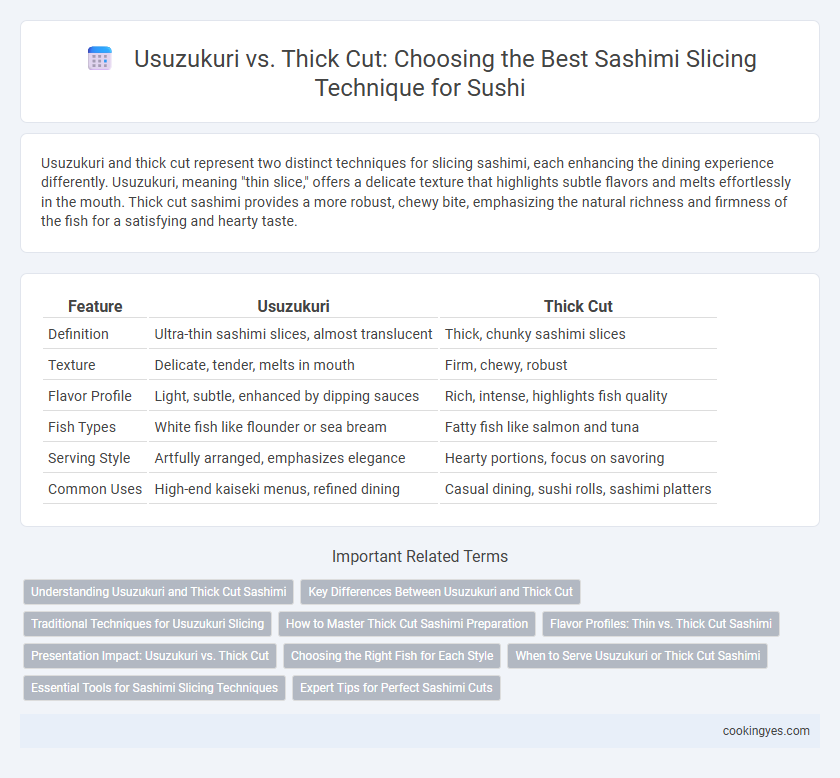Usuzukuri and thick cut represent two distinct techniques for slicing sashimi, each enhancing the dining experience differently. Usuzukuri, meaning "thin slice," offers a delicate texture that highlights subtle flavors and melts effortlessly in the mouth. Thick cut sashimi provides a more robust, chewy bite, emphasizing the natural richness and firmness of the fish for a satisfying and hearty taste.
Table of Comparison
| Feature | Usuzukuri | Thick Cut |
|---|---|---|
| Definition | Ultra-thin sashimi slices, almost translucent | Thick, chunky sashimi slices |
| Texture | Delicate, tender, melts in mouth | Firm, chewy, robust |
| Flavor Profile | Light, subtle, enhanced by dipping sauces | Rich, intense, highlights fish quality |
| Fish Types | White fish like flounder or sea bream | Fatty fish like salmon and tuna |
| Serving Style | Artfully arranged, emphasizes elegance | Hearty portions, focus on savoring |
| Common Uses | High-end kaiseki menus, refined dining | Casual dining, sushi rolls, sashimi platters |
Understanding Usuzukuri and Thick Cut Sashimi
Usuzukuri sashimi is characterized by its paper-thin slices, allowing delicate textures and subtle flavors of fish like flounder or sea bream to shine through, enhancing the melt-in-the-mouth experience. Thick cut sashimi, on the other hand, emphasizes a more robust, chewy texture and a pronounced flavor profile, often used for fatty tuna or salmon to highlight their richness. Understanding the contrast between usuzukuri and thick cut techniques is essential for appreciating the diverse sensory qualities and traditional craftsmanship in Japanese sashimi preparation.
Key Differences Between Usuzukuri and Thick Cut
Usuzukuri sashimi is sliced paper-thin, typically 1-2 mm, emphasizing delicate texture and subtle flavors, ideal for white fish like flounder or sea bass. Thick cut sashimi, usually 5-10 mm, offers a more robust bite and intense taste, commonly used for fatty tuna (otoro) and salmon. The primary difference lies in thickness, which affects mouthfeel, flavor release, and presentation style in traditional Japanese cuisine.
Traditional Techniques for Usuzukuri Slicing
Usuzukuri sashimi slicing requires precise knife skills to create paper-thin slices that enhance the delicate texture and flavor of fish like flounder or sea bream. Traditional techniques emphasize a sharp yanagiba blade and a single, smooth pull-cut motion to maintain the fish's integrity and presentation. In contrast, thick cut sashimi prioritizes a hearty bite and robust texture, often using more generous portions to highlight the fish's natural fattiness.
How to Master Thick Cut Sashimi Preparation
Mastering thick cut sashimi preparation requires precise knife skills and understanding fish texture to enhance flavor and mouthfeel. Unlike usuzukuri's ultra-thin slicing, thick cut sashimi emphasizes bold flavor and firm bite, ideal for fish like tuna or salmon with rich fat content. Proper chilling, selecting fresh fish, and slicing at a consistent angle ensure optimal thickness and presentation, elevating sashimi dining experiences.
Flavor Profiles: Thin vs. Thick Cut Sashimi
Usuzukuri sashimi, sliced paper-thin, enhances delicate flavors and provides a melt-in-the-mouth texture, allowing subtle umami and freshness to shine through. Thick cut sashimi offers a more robust and chewy bite, concentrating the fish's natural oils and delivering a richer, fuller taste experience. Each style emphasizes different flavor profiles, with usuzukuri highlighting elegance and lightness, while thick cuts emphasize intensity and texture.
Presentation Impact: Usuzukuri vs. Thick Cut
Usuzukuri sashimi, sliced paper-thin, creates a delicate, translucent presentation that highlights the freshness and texture of premium fish, making each slice appear almost ethereal on the plate. Thick cut sashimi offers a more robust, substantial appearance with bold edges that emphasize the richness and marbling of the fish, appealing visually to those who appreciate a hearty bite. The contrast in presentation between usuzukuri and thick cut sashimi directly impacts the diner's perception of taste and refinement, with thin slices evoking elegance and thick slices conveying intensity.
Choosing the Right Fish for Each Style
Usuzukuri sashimi requires ultra-fresh, firm-textured fish like flounder or sea bream to achieve delicate, translucent slices that highlight subtle flavors. Thick cut sashimi suits fattier fish such as salmon or tuna, where the bold texture and rich taste are emphasized through more substantial portions. Selecting the right fish based on texture and fat content ensures optimal flavor and presentation for each slicing style.
When to Serve Usuzukuri or Thick Cut Sashimi
Usuzukuri sashimi, characterized by its ultra-thin slices, is best served when using delicate fish like flounder or sea bream to highlight subtle flavors and tender texture. Thick cut sashimi is ideal for heartier fish such as tuna or salmon, offering a richer mouthfeel and robust taste. Choose usuzukuri for refined, light presentations and thick cut for sashimi that emphasizes boldness and chewiness.
Essential Tools for Sashimi Slicing Techniques
Essential tools for sashimi slicing, such as the yanagiba knife, must be razor-sharp to achieve the precision required for usuzukuri's ultra-thin slices and thick cut's bold, substantial pieces. A well-honed deba knife assists in filleting the fish before the delicate slicing process begins, ensuring clean cuts without damaging the flesh. Proper use of a cutting board with a non-slip surface enhances control and maintains the integrity of both usuzukuri and thick sashimi cuts.
Expert Tips for Perfect Sashimi Cuts
Usuzukuri, known for its ultra-thin slices, enhances delicate textures and subtle flavors in sashimi, demanding a razor-sharp blade and steady hand for precision. Thick cut sashimi emphasizes a richer, meatier bite, ideal for showcasing fatty fish varieties like toro, requiring firm yet gentle slicing to maintain the fish's integrity. Expert tips include chilling the fish to firm up flesh and using a single, smooth pull-cut to avoid jagged edges, ensuring optimal presentation and taste.
Usuzukuri vs Thick Cut for sashimi slicing Infographic

 cookingyes.com
cookingyes.com